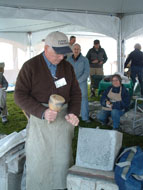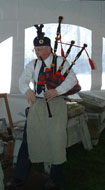- Details
-
Created: Monday, 02 May 2005 02:28
(Editor’s note: this is published to maybe get some of us off dead center and involved with the inner workings of fellow sculptors’ minds).
Lately, in the midst of sculpting, I have taken time to listen, hear my thoughts, and feel my feelings. I’ve found that my passions are interwoven with my fears, each competes for my undivided attention, and leaves a wake that is, darn it, troubling and familiar. Granted, I may want to believe I’m immune, or too mature, too sophisticated, too educated, too shy or too confident to feel or hear my internal anxiety. And yet, there is that Little Voice, every time I step foot into my studio, or a gallery, or sculptor’s meeting, or wherever! Eric Maisel, author of Fearless Creating, put it succinctly: “If you are to create, you must invite anxiety in.”
So I am moved to ask other artists, does anxiety trouble your creative process, and how do you work with it?
As a group, what might it look like to share those experiences? I have the impression we walk on common ground, and it might be fun, albeit scary, to explore fear and the creative process together.
In pondering the wealth of support inherent in our mission together, I wanted to broach this subject of the Little Voice and see what might emerge through our collective discussion. At our meetings, how might this topic be incorporated? My experience, in other groups, is that such disclosure can lead to greater trust and appreciation for one another. Yes, I know the risk of exposing myself on the thruway of art goes both directions - it can be inspiring or unnerving. Whatever shadows are pushing against me are just the starting points, with my Little Voice just aching to say something. So whether I put that message into a piece of art or a conversation, it still demonstrates power, passion, and magic to assist my journey to reveal more layers of myself.
What do you think and feel about your Little Voice? Would you be willing to share a part of that during our meetings or online? Something simple, like:
What is your view of success and failure?
What are your goals and ambitions?
How do you value gallery or show sales, commissions, awards, and local or national critiques?
Do you have biases? (figurative-abstract-wildlife-minimalist-modern-whatever)? Why?
When are your buttons pushed? How do you react? What wisdom will you offer?
No doubt this pond could be quite deep and intriguing to explore. My selfish Little Voice not only wants to be heard, it is curious and also wants to understand yours. A sculptor in the PNWS group (pnwsculptors.org) encouraged me to write, so I have stuck out my neck, and the view from the precipice is inviting! Get in touch with me: This email address is being protected from spambots. You need JavaScript enabled to view it., (503) 267-8703.
- Details
-
Created: Monday, 02 May 2005 02:23
There are special places that can act as a talisman for the artist. Finding them can be fun and rewarding. The trick is to be aware at all times that they may be in the most unexpected places, and happen at unexpected times. It just requires that you keep an open mind and be ready to accept what those special places have to offer. The real wonder and blessing of these places is that we can take them with us in our memories wherever we go. We have only to close our eyes and remember in order to have the nurturing that we may need at any moment.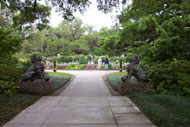
Special places exist all around us. We have only to be aware to feel the power and peace and inspiration that they possess. Then lock that impression in your memory by focusing on some feature that is strong and vivid. Later you will want to be able to recall this place in detail so that your mind will take you there again. It always amazes me that all the feelings and inspiration come tumbling back when I take the time to remember. But the first step is to find those places, and that can be a great adventure.
One of my favorite places was recommended to me by a friend that I met while cruising the east coast. Brookgreen Gardens are a magical place where sculpture and nature come together in a synergistic way and create more than the sum of the parts. The land had been rice plantations prior to the Civil War and had been all but deserted since. In the 1930s three of these plantations were purchased by Ann Hyatt and Archer Huntington. Ann was thought to have TB and they were seeking a warmer place to spend the winters than NY City. Ann was a very successful sculptor; her art can still be seen throughout the US and Europe, especially in NY City.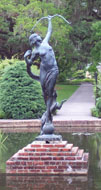
After starting the house that they wanted on the beach they looked at the old plantation house location. They realized that the 225 year old oak alley and deserted gardens would make a wonderful venue for Ann’s sculpture and the collection that they were beginning to acquire from her friends and colleges.
From that beginning the sculpture gardens have grown to cover 50 acres exhibiting as many as 900 sculptures of figurative American artists. It is a lush place of intimate walled gardens and sweeping lawns. The oak alley stretches for some two miles from the highway to a pond that was built on the site of the old burned-out hulk of the original house at the edge of the swamps, which are now returning to their natural state after 150 years of being left to themselves. There is, also, a wildlife preserve on the grounds and guided tours are given throughout the day. Volunteers give lectures and tours which all come with the cost of admission.
The art work spans 100 years of American art including many current works with new and exciting work on the way.
Into this place I came, unaware of the impact it would have on me. Entering through a massive gate that was guarded by a cast aluminum sculpture of a man and horse, I was struck by the magnificence of the landscape and the verdant green of the live oaks leading me into the heart of this amazing place. It was as if it was there just for me, to nourish and sustain me. The art was everywhere, in expected and unexpected places, ready for me to seek it out. In those gardens I found a place that will live in my heart and furnish me with inspiration and peace whenever I will take a moment to go there in my mind. I have only to remember that it is there, waiting for me to venture there again.
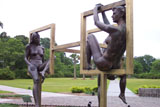
There are so many aspects to this experience, so much more that I could tell you about these gardens but it would be dry facts and would lose something in the telling. Now it is your turn to tell of those places that have brought joy and meaning to your artistic life. I hope that you will share with us your special place and tell us how it nourishes you in time of need or joy.
